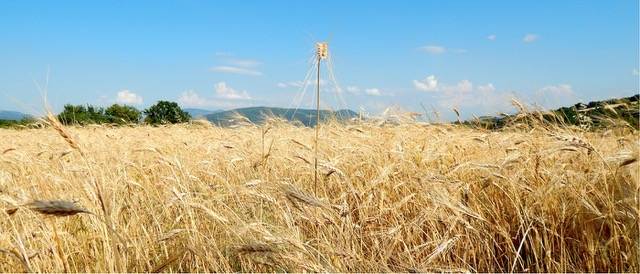THE PASTA PLATE Unlike bread, we don’t tend to overthink pasta. If our daily bread is increasingly less run of the mill, more sourdough, long fermented, high-hydration and stoneground, pasta has remained largely just flour and water and eggs. In fact, despite London’s fresh pasta renaissance, in raw material terms pasta is still largely stuck where bread was five years ago - in a dark age overrun by white, refined, large-corporation flours. And in the right hands, well - it tastes pretty fine.

The Pasta Plate
La Pasta Di Sabatino | Sassoferrato, Le Marche
The thing is - if London can make pasta as good as its current offering, and without shaking up the system, then why change? Why swap in a portion of that semola or 00 for buckwheat say, or khorasan - no or low gluten flours which are hard to work with, when they introduce uncertainty into the kitchen? The service of pasta is surely serviceability, dependability and consistency. If that goes, does this staple need to find a new place on the menu?
So why change? Because when those fragile, landrace grains find a place on a plate and on the menu, suddenly that grain gets a bit less fragile. It appears on another menu, it gains some followers, and before we know it, a farmer heroically preserving a piece of edible heritage, in a tiny pocket of Italy, has a bit of a market. Chefs, more than any other person in the food industry are in the position to trigger that change. It doesn’t have to be just pasta, it can be bigger than that: that plate of pasta can help to change the world.
Saragolla grows to 180cm tall in Dino and Bruno's organic fields.
Making pasta with landrace grain is hard. Bruno Vitaletti and Dino Paoletti know this, after nearly 10 years refining and further refining the process of working with the majestic Saragolla wheat, which is the grain species they grow. In early experiments, its low-gluten profile made for pasta that broke on cooking. And their project remains an unfinished process. But the pasta today has arrived at something that is wholly expressive of the unique characteristics of this ancient wheat, whilst satisfying Bruno and Dino’s rigorous quality control.
KHORASAN SARAGOLLA is a landrace grain, a sub-species of the ancient, Iranian wheat Khorasan. Landrace means it has evolved through centuries of natural mutations and recombinations, via migration and genetic drift, and via the minute decision makings of small farmers, into the grain we eat today. It has existed in total symbiosis with the environment in which it has grown and it has never - unlike an improved variety, been subject to organised or conscious selection (breeding). As such, it has compromised none of its ancient flavour, identity and distinction through improvements in the name of yield, mechanised harvesting and adaptability. When Dino and Bruno tasted their first, tiny harvest, they were stunned by Saragolla's difference: a burnished gold colour, nutty and distinctively rich in flavour. It was this taste that convinced them to keep going.
KHORASAN VS. KAMUT If we know Khorasan at all, we likely know it as Kamut. But Kamut is not a wheat, it is a Montana-based brand (Kamut International in fact), representing just one, trademarked, sub-species of Khorasan. Its marketing has been so successful that Kamut has effectively monopolised the market for this particular species, marginalising other small producers and actually further endangering its fellow sub-species. Even within Italy, where Saragolla, Zingaresca, Bulgara, Turshesco, Saragolletta del Sannio Khorasan sub-species are grown, Italians eat imported Kamut, hardly freshly milled and shipped halfway across the world.
Dino and Bruno’s farming and pasta project then, is necessarily preservation - of the Khorasan Saragolla sub-species. Like a true landrace, Saragolla cannot grow anywhere, but it has found an ideal environment in their Sassoferrato hills. It grows organically, reaching a prehistoric 180cm at maturity (modern wheat is bred to grow small for mechanical harvesting) and yielding a barely commercial 1-2 tonnes of wheat per hectare. It is then stoneground at the local mill, to demand only - i.e when Dino and Bruno want to make a batch of pasta. The precious germ, oils and bran that stone-grinding preserves are then immediately captured in pasta extruded with bronze dies and dried long and slow according to Abruzzese tradition.
For Dino, an agronomist, and Bruno, an engineer, their project is a very personal one. Bruno had stopped eating dried pasta for years, after seeng wheat from polluted fields in Russia being imported abroad. Dino's son has a gluten insensitivity, and was unable to eat modern wheat pasta. Growing their own wheat was about starting to eat pasta again, themselves.
STONEGRINDING It’s often forgotten that a single grain of wheat is made up of three components: the fibrous, nutritious bran; the aromatic germ (the adult plant embryo); and the starch pocket, which is called the endosperm. Today, those first two parts are largely lost to our diets. Why? Because the ubiquitous, modern steel roller milling system strips the endosperm of its bran and germ in pursuit of flour without volatility, which is practically unspoilable. Even wholewheat flours, also put through those rollers, are recomposed flours; whose germ and bran, sterilised to preserve shelf-life, is re-added back with supplementary iron and vitamins to replace those lost to sterilisation. Stonegrinding, in contrast, which is the only method Dino and Bruno use, preserves the full integrity of that single grain of wheat. Post-grinding, the flour will be golden and pungent from the oils released by the living germ. Unlike unspoilable modern flours, it must be used immediately, just as we’d expect for any other plant we’d harvest from the field.
COOKING Saragolla’s characteristics make for a pasta which will not behave the same as a pasta made from 00 or semola flour. Reproaching it for not subbing in directly for another varietal is missing the point - it’s beauty is its difference, its non-assimilable qualities and integrity within a host of homogenous brands. We’d council experimentation and a shaking of our preconceptions surrounding what dried pasta is or should be. It’s important we learn to understand these rare species, if we’re going to preserve their future. We’ve seen it happen for bread; let’s not leave pasta out in the dark.

